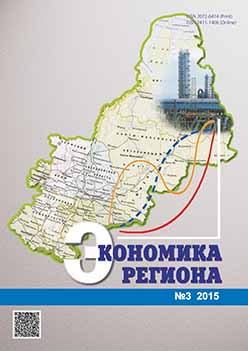Неравенство распределения дохода и экономический рост в регионах России в посткризисный период
Inequality of Income Distribution and Economics Growth in the Regions of Russia in the Post-Crisis Period
Author(s): Ruslan Arkadievich Grigoryev, Marat Vladimirovich Kramin, Timur Vladimirovich Kramin, Asiya Vitalyevna TimiryasovaSubject(s): Economy, Geography, Regional studies
Published by: Институт экономики Уральского отделения Российской академии наук
Keywords: income inequality; economic growth; the Gini coefficient; the competitiveness of regions; regression modeling; the gross regional product;
Summary/Abstract: Income distribution is one of the factors influencing economic growth. At present time, the regional aspect of such influence is an important sphere of research. The present article is intended to view the aspects of the influence of income distribution differentiation on economic growth on the example of the Russian regions in post-crisis period. The research results are presented in the form of regression model, estimating the differences in the growth rates of gross regional products in Russia in post-crisis 2010. The explanatory variables are Gini coefficients as an indicator of income inequality, and a number of other indicators characterizing the regional development in 2006 — 2010. Special attention is paid to the influence of 2008 crisis on the differences of regions by the level of dependent variable. Cross-sectional regression model based on the Russian Federation regions data shows the positive influence of changes in income distribution on the rate of economic growth. The general result of the research is confirmation of the hypothesis of the influence of income inequality on economic growth at the regional level in Russia. The observed effect is positive and statistically significant. The effect is relatively short-term, both from the point of view of the dependent variable (the yearly growth rate of GRP is used in the model), and from the point of view of the time lag between the year of dependent variable observation, 2010, and the period of observation, for which the Gini coefficient is significant in regression equation (2006-2007). Pre-crisis value of the Gini coefficient does not determined the differences in economic growth in the regions of Russia in 2011-2012. The results can be used in predicting the pace of regional development in Russia in the post-crisis period, as well as in the implementation of regional economic policy in times of crisis in order to maximize regional economic growth after the crisis.
Journal: Экономика региона
- Issue Year: 11/2015
- Issue No: 3
- Page Range: 102-113
- Page Count: 12
- Language: Russian

